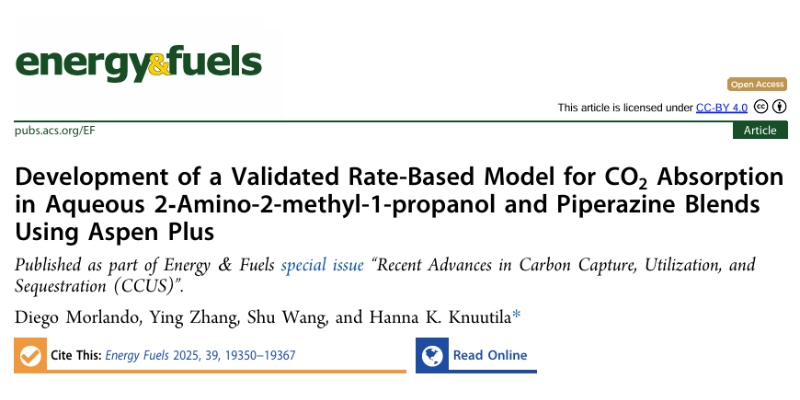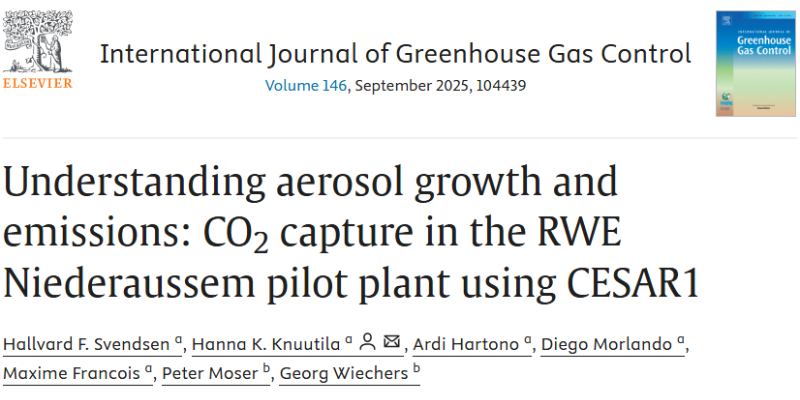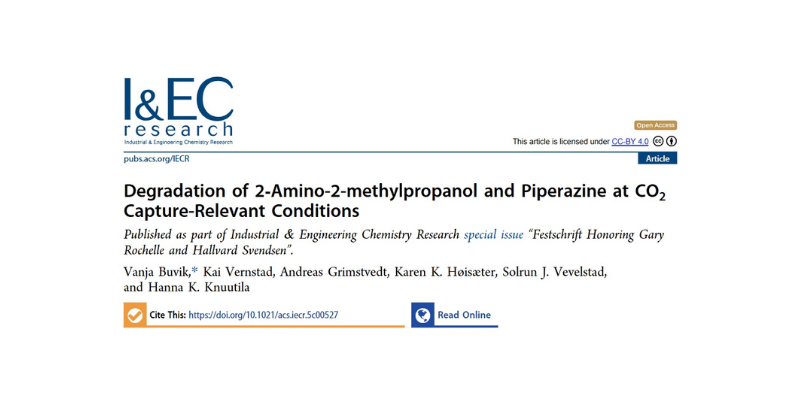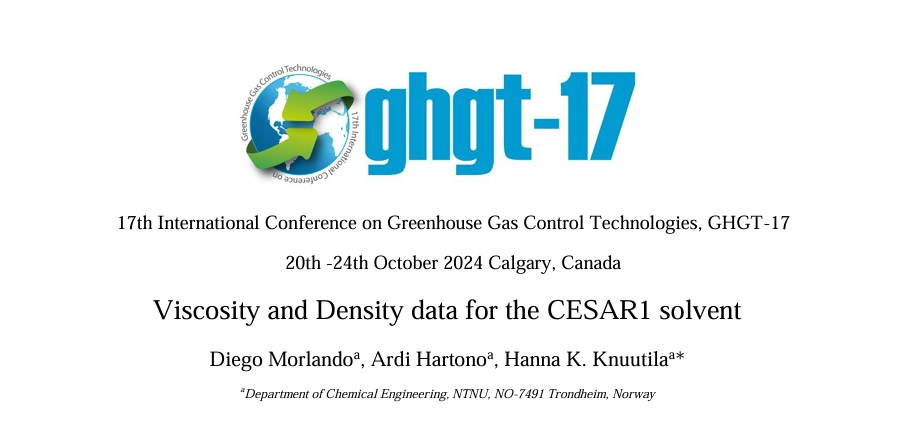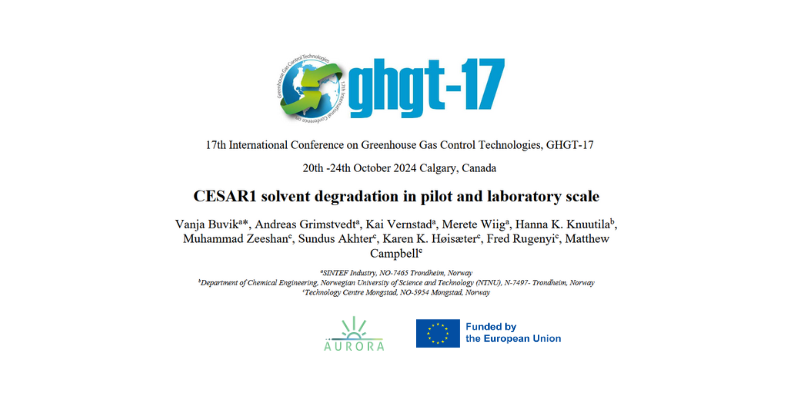AURORA latest review paper, developed in collaboration with researchers from SINTEF and NTNU, provides a comprehensive analysis of the CESAR1 solvent system. It collects and evaluates existing experimental data, highlights knowledge gaps, and outlines the necessary next steps in research to optimize the use of CESAR1 for CO₂ capture.
In the race to mitigate climate change, carbon capture technology has emerged as a crucial solution, and amine-based chemical absorption is leading the way for post-combustion CO₂ capture.
Among these technologies, the CESAR1 solvent system—a blend of 3 M 2-amino-2-methyl-1-propanol (AMP) and 1.5 M piperazine (PZ)—has attracted significant attention for its superior performance over traditional solvents.
CESAR1 promises better energy efficiency and lower degradation rates than the industry-standard ethanolamine (MEA). However, there are still critical knowledge gaps that must be addressed for CESAR1 to reach its full potential.
Why CESAR1 Stands Out in CO₂ Capture
CESAR1 has emerged as a leading candidate. Its low energy consumption is a key advantage when considering large-scale applications for power plants and industrial facilities. The system’s lower degradation rates also imply reduction in operational costs.
A Collaborative Effort
This review paper is the result of collaboration between NTNU and SINTEF to provide the most comprehensive analysis of the CESAR1 solvent system to date. The research was made possible by the support of the AURORA Project, funded by the European Union’s Horizon Europe programme.
The CESAR1 system represents a significant step forward in the development of more efficient CO₂ capture solutions. With further research and pilot plant testing, this solvent could play a critical role in the global effort to reduce greenhouse gas emissions and combat climate change.
Thanks to All Authors
Diego Morlando, Hanna Katariina Knuutila, Ardi Hartono and Hallvard F Svendsen from NTNU, Vanja Buvik, Asmira Delić, Hanne Marie Kvamsdal and Eirik Silva from SINTEF.
Filling in the knowledge gaps
The review paper identifies several areas where experimental data for CESAR1 is lacking or incomplete. Key findings include:
- Physical Properties and Thermodynamic Data: Important physical properties and such as viscosity, density and thermodynamic data, i.e. speciation data, are not yet available for the CESAR1 blend in the open literature. These data are essential for developing reliable process models that accurately predict the system’s performance.
- Degradation Compounds: The review outlines a major challenge with the CESAR1 system: the nitrogen balance for both AMP and PZ is not yet closed. This means there are still unknown degradation products that need to be identified and quantified, which is essential for understanding the long-term performance and environmental impact of CESAR1.
- Emissions and Environmental Impact: One of the most pressing concerns is the potential for aerosol and gas-phase emissions, particularly due to AMP’s higher volatility compared to MEA. A better understanding of how these emissions form and behave in real-world applications is crucial. The review also highlights the need for the assessment of the environmental impact and toxicity of CESAR1 components.
Future Directions for CESAR1 Research
To ensure CESAR1 fulfils its promise as the next-benchmark solvent for CO₂ capture, the review proposes several areas for future research:
- Comprehensive Data Collection: Gathering the missing experimental data is a priority. This includes closing the nitrogen balance for AMP and PZ, identifying unknown degradation compounds, improving our understanding of CESAR1’s emissions profile and provide reliable physical properties, thermodynamic and kinetics data for the CESAR1 blend.
- Process Model Development: With better data, more accurate process models can be developed, allowing scientists to predict CESAR1’s performance in large-scale applications more reliably. This is crucial for the optimization of energy consumption and overall system efficiency.
- Environmental Impact Studies: More research is needed to assess the long-term environmental impact of CESAR1, including its potential toxicity and effects on air and water quality.
Publication – Development of a Validated Rate-Based Model
Abstract In this work, we developed a new e-NRTL thermodynamic framework for CO2 absorption in aqueous mixtures of 2-amino-2-methyl-1-propanol (AMP) and piperazine (PZ) in Aspen Plus. The e-NRTL AMP/PZ/H2O/CO2 model was fitted on experimental data covering a range of AMP concentration from 12 to 48 mass % and PZ concentration…
Publication – Pilot-scale CO2 capture in a cement plant with CESAR1
Abstract Carbon capture from hard-to-abate industries is essential. This study investigates the effect of stripper pressure on the performance of amine-based CO2 capture from cement flue gas, using the CESAR1 solvent. Through a rigorous data filtering and binning methodology, experimental results were systematically categorized, enabling a precise evaluation of how…
New Publication: Aerosol Modeling in CO2 absorption using CESAR1
We are proud to announce that Hallvard F. Svendsen, Hanna K. Knuutila, Ardi Hartono, Maxime Francois and Diego Morlando at NTNU, together with external collaborators Peter Moser (RWE) and Georg Wiechers (RWE) have published a new article presenting results from the AURORA and SCOPE projects.The publication introduces a new class-based…
Thermodynamic Properties of CO₂ Absorption in CESAR1 — Essential Data for Better Process Modelling
We are proud to announce a new scientific publication from the AURORA project, authored by Diego Morlando, Ardi Hartono and Hanna K. Knuutila, published in Carbon Capture Science & Technology. This important work provides extensive experimental data on the thermodynamic properties of CESAR1, a key solvent blend for industrial carbon…
Journal Publication – In-Depth Study of CESAR1 Solvent Degradation Under CO₂ Capture Conditions
A new scientific publication based on research from the AURORA project has just been released in the journal Industrial & Engineering Chemistry Research. This study delivers an in-depth analysis of the degradation behaviour of the CESAR1 solvent —a popular choice for solvent-based post-combustion CO₂ capture.This work, developed under the AURORA…
Conference publication – GHGT-17: Viscosity and Density data for the CESAR1 solvent
Abstract Global warming is a major issue that needs to be addressed and limited. The CESAR1 solvent blend has a high potential for becoming a commonly employed, commercial solvent system. In this work, the viscosity and density data for aqueous CO2 loaded CESAR1 (26.6 wt.% AMP 12.8 wt.% PZ) solution…
Conference publication – GHGT-17: “Storage potential evaluation of eastern Mediterranean area as final step of the full chainassessment”
The final step in capturing and storing carbon dioxide (CO₂) emissions is geological storage, where CO₂ is injected deep underground into carefully chosen locations. These locations could be natural formations like saline aquifers (underground reservoirs filled with salty water) or empty oil and gas fields.This work, part of the AURORA…
Understanding Solvent Degradation in CO₂ Capture – CESAR1 Solvent Degradation in Pilot and Laboratory Scale
The fight against climate change requires innovative solutions, and one promising method is CO₂ capture and storage (CCS). CCS involves capturing carbon dioxide from industrial emissions before it reaches the atmosphere. At the heart of this process are specialized chemical solvents, such as CESAR1, which absorb CO₂ from flue gases.While…
Turning Waste Into Opportunity: Thermal Reclamation Chemistry of Common Amine Solvents
CO2 capture technology is vital for reducing greenhouse gas emissions. But what happens when the chemicals used in this process wear out or degrade? Scientists have been studying how to rejuvenate these chemicals through a method called thermal reclaiming. This research focuses on ethanolamine (MEA), a widely used solvent for…
Closing Knowledge Gaps – Density and Viscosity of Unloaded and CO2-loaded Aqueous AMP-PZ blends
AURORA’s latest scientific journal publication provides experimental density and viscosity data on different unloaded and CO2-loaded aqueous blends of 2-amino-2-methyl-1-propanol (AMP) and piperazine (PZ) used for absorption-based CO2 capture. The paper also provides correlations for density and viscosity suitable for various modelling works.In our previous review article, we identified knowledge…


